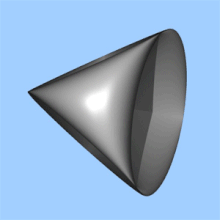Steiner surface
Steiner's surfaces are special surfaces in projective geometry on which families of conic sections lie. They are named after Jakob Steiner (1796–1863), who found them in 1838 when he was in Rome . Special Steiner areas are therefore also called Roman or Roman areas . The Steiner surfaces have been investigated further by Ernst Eduard Kummer and Karl Weierstrass . A Steiner surface is a surface in three-dimensional space given by quadratic polynomials in two variables :
In affine coordinates it is given by an equation at most of the fourth degree.
Behind this is the following construction: The real projective plane , given by homogeneous coordinates , is embedded in the projective 5-dimensional space, with homogeneous coordinates (Veronese surface):
Then projected through multiplication with a 6 × 4 matrix on the four-dimensional space, which gives four linear combinations of the six homogeneous coordinates given above: . Understood as the homogeneous coordinates of the three-dimensional projective space (this transition creates singularities of the surface), the above representation of the Steiner surface results.
Examples
The Roman area of Steiner is through
given. The representation is homogeneous in the , so that further parameterizations can easily result if one multiplies with a common factor (see below). It has three double lines, six branch points and one triple point. The three double lines, where the surface penetrates itself, meet at the triple point. The surface cannot be oriented (i.e. one-sided like the Möbius strip ), just like the projective plane, which is embedded in the three-dimensional space according to the above construction. In affine coordinates it has the equation:
Further parameterizations of the equation are given by:
what results from taking advantage of the homogeneity of the representation in the form , and
It results from the parameterization of the unit sphere
and the figure
The cross hood is given by:
In affine coordinates:
Coffman, Schwartz and Stanton classified the possible Steiner surfaces into 10 types.
literature
- A. Coffman, A. Schwartz, C. Stanton: The Algebra and Geometry of Steiner and other Quadratically Parametrizable Surfaces . In: Computer Aided Geometric Design , (3) 13 April 1996, pp. 257-286
- Bert Jüttler, Ragni Piene: Geometric Modeling and Algebraic Geometry . Springer, 2008, ISBN 978-3-540-72184-0 , p. 30 ff. ( Limited online version in Google Book Search - USA )
- Steiner surface . In: Meyers Großes Konversations-Lexikon . 6th edition. Volume 18, Bibliographisches Institut, Leipzig / Vienna 1909, p. 900 .
Web links
- Steiner Surfaces . Coffman (English)
- Eric W. Weisstein : Steiner Surface . In: MathWorld (English).
- Roman Surfaces at National Curve Bank (California State University website)
- Eric W. Weisstein : Roman Surface . In: MathWorld (English).
References and comments
- ↑ Another embedding of the projective plane is given by the Boy surface , which is not a Steiner surface.





















